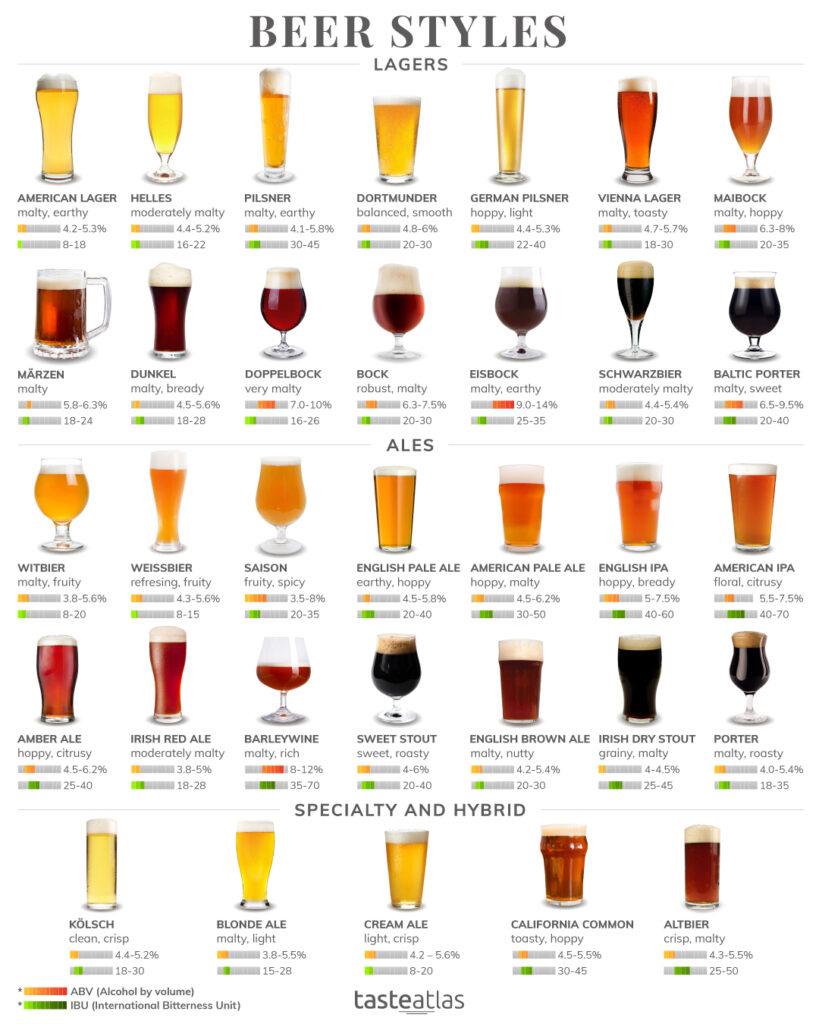
I will have several internal links pointed to this post for beer styles and various beer definitions. I figured if we’re going to talk about various styles of beer, we should have a definitions page to define what they are.
Let me know if you don’t see a particular style on this list, there’s a good chance that it’s listed or classified under another style, or I just haven’t added it yet. I’ll be continuing to add styles (probably forever) and depending on what resource you look at; the styles are listed differently.
All beers are broken down into 2 main categories – Ales and Lagers. Believe it or not, almost all beers fall under these 2 categories, and then are broken down into subcategories – and there are A LOT of them. The reason I said “almost all beers” is there is a 3rd category that is recognized by The Brewers Association and it’s a combination of Ales and Lagers called Hybrid/Mixed Lagers or Ale. We’re going to use that category as well as there are many beers that don’t really fit a particular category.
Most, if not all, of the information here will be sourced from The Brewers Association and will be cited properly. The Brewers Association is a trusted organization of brewers that help to promote and protect craft brewers, craft beer and the craft beer community. Please read their “Who We Are” page to learn more about them here: Who We Are – For Brewers and By Brewers – Brewers Association
Ales
Merriam-Webster defines an Ale as “a beer that is brewed by fast fermentation with a quick acting yeast at relatively high temperatures“. In real terms, Ales are typically fermented at room temperature and the fermentation happens at the top of the fermenter.
- American Barleywine – Clear and light brown in color to amber. Based on English Barleywine but with more hops. High ABV from 8%-12.2%*. Bitter with the high alcohol in the aroma and on the palate. Very strong finish.
- Double / Imperial IPA – Originated to keep beer fresher longer on voyages from England to India. Hop-forward, bitter, floral, piney on flavor and aroma. Malt used in brewing to balance out the hops. Additional hops added vs. a standard IPA for more bitterness in flavor and aroma. Higher ABV’s at 7.6%-10.6%*.
- Dry Irish Stout – Black in color. Prominent coffee-like roasted barley and moderate roasted malt aroma and flavor. European hop character may range from not present to low in aroma and flavor. Medium-light to medium in body.
- Extra Special Bitter (ESB) – Amber to deep copper in color. Medium to medium-high in malt aroma, flavor, hop aroma and flavor. Medium to medium-high in bitterness. Medium in body. ABV is between 3.8% – 4.6%*. IBU’s from 30-45*.
- Milk / Cream/ Sweet Stout – First mass produced in the 1900’s as a “tonic for invalids and nursing mothers”**. Dark in color due to the black malt used to brew with added lactose (milk sugar). Robust flavors and aromas including sweetened coffee, espresso and chocolate with no hoppiness. Creamy and silky on the mouthfeel with low carbonation.
- Imperial / Russian Imperial Stout – The name originated as it was supplied to the Russian Imperial court of Czarina Catherine the Great. Dark in color due to the dark malt used to brew. Robust flavors and aromas including bitter coffee, chocolate and hops. Richer, fuller and higher in ABV at 7%-12%*, than a standard Stout.
- India Pale Ale (IPA) American Style– Pale to copper in color. High to very high hop aroma and flavors, which include floral, piney, citrus, fruity and diesel-like. Bitterness is medium-high to very high. Typical ABV is 6.3% to 7.5% with IBU’s 50-70. Originated to keep beer fresher longer on voyages from England to India by adding additional hops and was widespread in England by 1815. Malt used in brewing to balance out the hops which could lead to a higher ABV.
- New England IPA (NEIPA) – Originated from Vermont. Fruity and Tropical flavors and aromas. Less bitter than traditional IPA’s. Hazy in appearance with lower carbonation.
- New England Double IPA (NEDIPA) – Originated from Vermont. Fruity and Tropical flavors and aromas. Less bitter than traditional IPA’s. ABV is between 7.6%-10.6%*.
- Pale Ale (American Style)- Originated in England in 1703. Golden to Amber in color. Hop-forward, bitter, flavorful, malty but not heavy. Low to medium maltiness in flavor and aroma, high hop aroma and flavor including floral, citrus, fruity and piney. Bitterness is medium to medium-high. Typical ABV is 4.4%-5.4% with IBU’s 30-50.
- Porter (Brown) – Dark brown to very dark in color, possibly has a red tint. Low to medium malt sweetness with caramel and chocolate characteristics. Very low to medium aroma and flavor hops and bitterness. Typical ABV is between 3.5% – 4.7%. IBU’s between 20-30*.
- Porter (Robust) – Very dark brown to black in color. Medium to medium-high malt aroma and flavor. Medium to high bitterness. Very low to medium aroma and flavor hops. ABV is between 4% – 5.2%. IBU’s between 25-40*.
- Stout (American Style)– Originally called Stout Porters. Dark in color due to the roasted malt and barley used to brew. Robust flavors and aromas including coffee and chocolate with medium to high bitterness because of the American hops used. Typical ABV is between 4.5% – 6.4% with IBU’s 35-60.
- West Coast IPA (WCIPA) – Originated on the west coast of the U.S. Clear in color, dry, crisp, bitter, with piney and citrusy flavors. Hoppy aroma due to the type of hops used.
Lagers
Merriam-Webster defines a Lager as “a beer that is brewed at cool temperatures by slow fermentation with slow-acting yeast”. In real terms, Lagers are fermented at cooler temperatures than Ales and the fermentation occurs at the bottom of the fermenter.
- American Amber Lager –
- American Lager – Straw to gold in color and chill haze should not be present. Malt sweetness is very low to low. Hop aroma, flavor and bitterness is very low to not present. Usually brewed with corn, rice or other grains. American lagers are very clean, crisp and aggressively carbonated. Typical ABV is 4.1% to 5.1% with IBU’s from 5-15. Originated in the mid-19th century and moved to the US with German immigrants.
- American Light Lager –
- American Pilsner –
- American Oktoberfest –
- German Lager –
- German Pilsner –
- German Oktoberfest –
Hybrid/Mixed Lagers or Ales
As stated above, this is a category that is either a mix of the 2 previous categories or a category to put a beer style that doesn’t really qualify as an Ale or a Lager.
Other Beer Definitions
* = Information comes from Brewers Association at Brewers Association Beer Style Guidelines
** = Information comes from Vine Pair at What the Hell Is a Milk Stout? | VinePair
